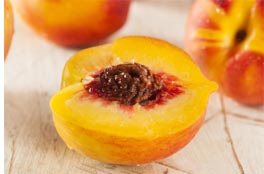Ten Tasty Facts You Probably Didn’t Know About the Peach
- By Seth Wright
- Reading Time: 3 mins.
Peaches have been on my mind lately. They are my favorite fruit, and they grow bountifully and beautifully in the Capay Valley. Many of our farms here cultivate more than one variety, and I feel blessed to have the opportunity to try so many different varieties of this sweet, juicy, and perfect fruit. To celebrate National Peach Month, here are 10 interesting facts that you probably didn’t know about the peach.
1. Although no one is really sure why peaches have that fuzzy, nuisance of skin, there is a theory. It suggests that the peach fuzz acts as an irritant to destructive insects, and prevents them from eating the fruit. Whatever the reason may be, I wish it didn’t make eating a peach such an itchy experience.
2. Georgia may be the state most well known for peaches, but it is not the state that grows the largest quantity of this tasty fruit. It actually is ranked third. California grows more peaches than any other state in the nation followed by South Carolina.
3. Peaches originated in China where they have been cultivated there for more than 3,000 years, and China is still the number one producer of peaches in the world. The peach was then brought to and cultivated in India and the Middle East where they were introduced to the Europeans. Spanish settlers brought the peach to the Americas in the 16th century.
4. The peach tree belongs to the same family of trees as roses and almonds. That’s a pretty diverse family tree; pun intended.
 5. There are hundreds of varieties of peaches in existence today, but all peaches are categorized into two types: freestones and clingstones. The flesh of freestone peaches separates easily from the pit, which makes them ideal for eating fresh. In clingstone varieties, the flesh of the peach clings to the pit. These varieties are best for canning.
5. There are hundreds of varieties of peaches in existence today, but all peaches are categorized into two types: freestones and clingstones. The flesh of freestone peaches separates easily from the pit, which makes them ideal for eating fresh. In clingstone varieties, the flesh of the peach clings to the pit. These varieties are best for canning.
6. It is a common misconception that a peach/plum hybrid is the nectarine. This, however, is not actually the case. A nectarine is actually just a variety of peach with smooth rather than fuzzy skin. In this case, fuzzy skin is a dominant trait; whereas the smooth skin of a nectarine is a recessive trait.
7. According to The Wall Street Journal, the Water Honey peach, which is grown in Yangshan, China, is reportedly the best peach in the world. It would also be the most expensive if peaches had a long enough shelf life to cross the Pacific Ocean. These peaches have light green skin, with soft and incredibly juicy white flesh.
8. Peaches are incredibly nutritious. Not only are peaches high in fiber and potassium, but they also contain reasonable amounts of antioxidant vitamins A and C. There is also scientific evidence that suggests that peach extracts are effective at killing breast cancer cells.
9. Peach pits contain the chemical hydrocyanic acid, which in large amounts can be poisonous. But don’t worry about that too much, an adult would have to eat about 10 peach pits in one day to receive a dangerous dose of this chemical. It’s a good thing those pits don’t taste good.
10. The largest peach on record with the Guinness Book of World records weighed an astonishing 25.6 ounces; that’s roughly a pound and a half of peachy deliciousness. It was picked in August of 2002 in Coloma, Michigan, (sorry California, South Carolina, and Georgia)!
Happy National Peach Month! We hope you continue to enjoy this delicious summer treat.
Want farm-fresh fruit?
We've got you covered.This article is written by Farm Shop Team Member Seth Wright, courtesy of Capay Valley Farm Shop


